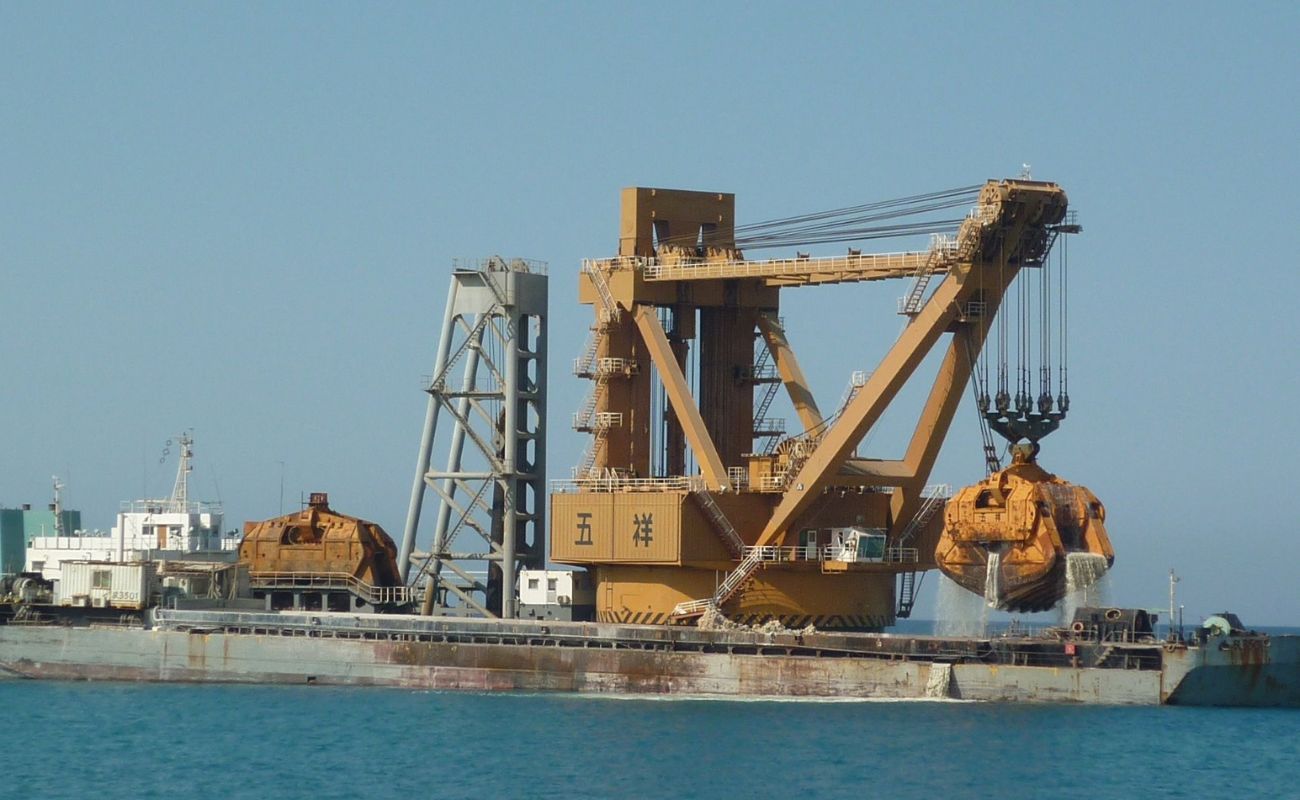Home>diy>Planning & Engineering>What Is Marine Civil Engineering


Planning & Engineering
What Is Marine Civil Engineering
Modified: January 9, 2024
Learn about the fascinating field of marine civil engineering and the important role it plays in the planning and engineering of waterfront structures and coastal development.
(Many of the links in this article redirect to a specific reviewed product. Your purchase of these products through affiliate links helps to generate commission for Storables.com, at no extra cost. Learn more)
Introduction
Marine civil engineering is a branch of civil engineering that focuses on the design, construction, and maintenance of structures and infrastructure in coastal and marine environments. It deals with the unique challenges presented by the dynamic and often harsh conditions of the ocean, such as waves, tides, currents, and corrosive saltwater.
This field of engineering plays a crucial role in the development and preservation of coastal areas, harbors, ports, offshore oil and gas installations, and other marine infrastructure. It combines principles of civil engineering, geotechnical engineering, structural engineering, environmental engineering, and oceanography to ensure the successful completion of projects while minimizing the impact on marine ecosystems.
In recent years, the importance of marine civil engineering has grown significantly as coastal cities and countries seek to harness the potential of marine resources, protect coastal communities from natural disasters, and facilitate global trade through efficient port facilities. This article will explore the different aspects of marine civil engineering, its significance, the role of marine civil engineers, notable projects in the field, challenges faced, and future trends.
Key Takeaways:
- Marine civil engineering is crucial for economic growth, coastal protection, clean energy, and disaster resilience. It combines diverse expertise to shape sustainable coastal and marine infrastructure.
- Marine civil engineers play key roles in site assessment, design, project management, and environmental conservation. They address challenges and drive innovation for resilient coastal and marine development.
Read more: What Is A Civil Engineering Technician
Definition of Marine Civil Engineering
Marine civil engineering involves the application of engineering principles and techniques to the planning, design, construction, and maintenance of structures and infrastructure in coastal and marine environments. It encompasses a wide range of projects, including the construction of ports, harbors, jetties, breakwaters, offshore platforms, coastal protection structures, underwater pipelines, and offshore wind farms.
One of the key aspects of marine civil engineering is the consideration of the unique challenges posed by marine environments. These challenges include the forces of waves, tides, and currents, the corrosive nature of saltwater, and the potential impact of sea-level rise and climate change. Engineers in this field must take these factors into account when designing structures that can withstand these harsh conditions.
Moreover, marine civil engineering involves a detailed understanding of coastal and oceanographic processes. Engineers must analyze the behavior of waves and currents to ensure the stability and safety of structures. They also need to study sediment transport and erosion to protect coastlines and maintain navigational channels.
In addition to the physical aspects, marine civil engineering also considers the environmental impacts of construction projects. Environmental assessments and mitigation measures are implemented to minimize harm to marine ecosystems and ensure compliance with environmental regulations.
Overall, marine civil engineering is an interdisciplinary field that combines various branches of engineering to address the specific challenges and requirements of coastal and marine environments. It requires a deep understanding of marine science, mechanics, materials, and geotechnical engineering to successfully execute projects while maintaining environmental sustainability.
Scope of Marine Civil Engineering
The scope of marine civil engineering is broad and encompasses a wide range of projects and activities related to coastal and marine infrastructure. Here are some key areas within the scope of this field:
- Port and harbor development: Marine civil engineers play a vital role in the planning and design of ports and harbors. This includes determining the layout of berths, navigation channels, breakwaters, and quay walls to facilitate safe and efficient vessel operations.
- Coastal protection: Protecting coastlines from erosion, storms, and sea-level rise is an essential aspect of marine civil engineering. Engineers design and construct coastal protection structures such as seawalls, revetments, beach nourishment projects, and offshore breakwaters to safeguard shorelines and coastal communities.
- Offshore structures: Marine civil engineers are involved in the design, construction, and maintenance of offshore structures, including offshore oil and gas platforms, wind turbines, and underwater pipelines. These structures must be engineered to withstand strong waves, currents, and harsh environmental conditions.
- Dredging and marine excavation: Dredging is another crucial aspect of marine civil engineering, involving the removal of sediment from waterways to maintain navigable channels or create new land for infrastructure development. Marine civil engineers oversee the dredging operations and ensure proper disposal of the dredged material.
- Subsea infrastructure: Marine civil engineers are responsible for the design and installation of subsea infrastructure, such as underwater cables, pipelines, and sewage outfalls. These structures require expertise in underwater construction methods to ensure their longevity and functionality.
- Coastal engineering: Coastal engineering focuses on managing the interaction between land and water in coastal areas. Marine civil engineers are involved in various coastal engineering projects, including beach nourishment, dune restoration, estuary management, and coastal erosion control.
- Environmental impact assessment: Marine civil engineers conduct environmental impact assessments to evaluate the potential ecological and socio-economic effects of construction projects in marine environments. They develop strategies to minimize or mitigate adverse impacts, ensuring sustainable development.
- Research and innovation: Marine civil engineering involves continuous research and innovation. Engineers contribute to the development of new materials, construction techniques, and sustainable solutions to address the evolving challenges of marine infrastructure development and environmental preservation.
Overall, the scope of marine civil engineering extends beyond the physical construction of structures and encompasses the management, preservation, and sustainable development of coastal and marine environments.
Importance of Marine Civil Engineering
Marine civil engineering plays a critical role in the development, maintenance, and protection of coastal and marine infrastructure. Here are some key reasons why this field is of utmost importance:
- Economic development: Marine infrastructure, such as ports and harbors, serve as gateways for international trade and commerce. They facilitate the import and export of goods, stimulate economic growth, and create job opportunities. Marine civil engineers contribute to the design and construction of efficient port facilities, ensuring smooth and safe operations for a thriving economy.
- Coastal protection: With rising sea levels and the increased frequency of storms, protecting coastlines from erosion and flooding is more crucial than ever. Marine civil engineers design and implement coastal protection measures to safeguard communities, infrastructure, and valuable coastal ecosystems. They play a vital role in minimizing the impacts of climate change and ensuring the sustainability of coastal areas.
- Energy production: Offshore oil and gas platforms and wind turbines are essential sources of energy. Marine civil engineers are responsible for the design and construction of these structures, which require specialized knowledge in underwater engineering and marine operations. They contribute to the development of sustainable and clean energy solutions, reducing reliance on fossil fuels.
- Environmental conservation: Marine civil engineering incorporates environmental considerations into the planning and execution of projects. Engineers study the potential impacts of construction on marine ecosystems and propose mitigation measures to protect biodiversity. They work closely with environmental experts to ensure that projects are executed in an environmentally responsible manner, preserving fragile marine habitats.
- Disaster resilience: Coastal areas are vulnerable to natural disasters such as hurricanes, tsunamis, and storm surges. Marine civil engineers design and construct structures that can withstand these extreme events, protecting lives and minimizing property damage. They contribute to the development of resilient infrastructure that can recover quickly after disasters, ensuring the safety and well-being of coastal communities.
- Tourism and recreation: Coastal areas are popular destinations for tourism and recreation. Marine civil engineers play a role in developing marinas, waterfront promenades, and other facilities that attract visitors and enhance the tourism industry. They create sustainable and aesthetically pleasing environments that provide recreational opportunities and improve the quality of life for residents.
- Research and innovation: Marine civil engineering is a field of continuous research and innovation. Engineers are at the forefront of developing new technologies, materials, and strategies to overcome the challenges of marine environments. Their advancements contribute to the advancement of the broader engineering field and drive progress in sustainable infrastructure development.
In summary, marine civil engineering is of significant importance as it supports economic growth, protects coastlines, harnesses clean energy, preserves the environment, builds disaster resilience, promotes tourism, and drives research and innovation. The expertise and contributions of marine civil engineers are essential for the sustainable development of coastal and marine areas.
Role of Marine Civil Engineers
Marine civil engineers play a crucial role in the planning, design, construction, and maintenance of infrastructure in coastal and marine environments. Their expertise is essential for ensuring the success and sustainability of various projects. Here are the key roles of marine civil engineers:
- Site assessment and feasibility: Marine civil engineers assess the site conditions and conduct feasibility studies for proposed projects. They evaluate factors such as wave climate, water depth, soil conditions, and environmental impact to determine if a project is viable and to propose appropriate design solutions.
- Design and engineering: Marine civil engineers are responsible for designing structures that can withstand the unique challenges of marine environments. They utilize their knowledge of structural and geotechnical engineering, wave dynamics, and materials science to create safe, efficient, and sustainable designs for coastal protection structures, ports, jetties, offshore platforms, and other marine infrastructure.
- Project management: Marine civil engineers oversee the execution of marine construction projects, ensuring that they are completed on time, within budget, and according to specifications. They manage teams of contractors, supervise construction activities, and ensure compliance with safety and environmental regulations.
- Environmental assessment and mitigation: Marine civil engineers conduct environmental impact assessments to identify potential ecological and socio-economic effects of construction projects. They develop mitigation measures to minimize harm to marine ecosystems and ensure compliance with environmental regulations. They collaborate with environmental experts to ensure that projects are executed in an environmentally responsible manner.
- Coastal and oceanographic studies: Marine civil engineers analyze coastal processes, including wave dynamics, sediment transport, and coastal erosion. They use this knowledge to develop strategies for managing erosion, maintaining navigable channels, and preserving coastal ecosystems. They also conduct studies to assess the impact of climate change on coastal areas.
- Construction and installation: Marine civil engineers oversee the construction and installation of marine infrastructure. This includes activities such as dredging, piling, concrete placement, and underwater welding. They ensure that construction methods are suitable for marine conditions and monitor progress to ensure quality and safety.
- Maintenance and repair: Marine civil engineers are responsible for the ongoing maintenance and repair of coastal and marine structures. They conduct regular inspections, assess structural integrity, and implement measures to prevent corrosion and deterioration. They also develop maintenance plans to ensure the long-term functionality and safety of marine infrastructure.
- Innovation and research: Marine civil engineers contribute to the advancement of the field through research and innovation. They develop new materials, construction techniques, and design solutions to address the evolving challenges of marine civil engineering. They collaborate with researchers, academia, and industry partners to drive progress in the field and find sustainable solutions for coastal and marine infrastructure development.
Through their various roles, marine civil engineers contribute to the successful completion of projects while ensuring environmental sustainability and the resilience of coastal and marine infrastructure. Their expertise and specialized knowledge are crucial for addressing the unique challenges of working in marine environments.
Marine civil engineering involves the design and construction of structures in or near water, such as ports, harbors, and offshore platforms. It requires a strong understanding of coastal processes and materials.
Read more: What Is Chainage In Civil Engineering
Key Projects in Marine Civil Engineering
Marine civil engineering has witnessed the completion of numerous notable projects that have had a significant impact on coastal and marine infrastructure development. Here are some key projects that highlight the importance and scope of this field:
- Panama Canal Expansion: The expansion of the Panama Canal is one of the most significant projects in marine civil engineering. Completed in 2016, the project involved the construction of new locks to accommodate larger vessels. The expansion has transformed global trade routes, allowing for the passage of larger container ships and facilitating increased trade between the Atlantic and Pacific Oceans.
- Palm Jumeirah, Dubai: Palm Jumeirah is an iconic artificial island located in Dubai, United Arab Emirates. It is one of several palm-shaped islands constructed in the Persian Gulf. Marine civil engineers played a vital role in the design and construction of the island, which involved extensive dredging, land reclamation, and the creation of shoreline protection structures. The project has become a popular tourist destination, showcasing the capabilities of marine civil engineering in creating innovative coastal developments.
- Oresund Bridge: The Oresund Bridge connects Denmark and Sweden, spanning the Oresund Strait. Completed in 2000, this impressive project combined a bridge, an artificial island, and an underwater tunnel. Marine civil engineers played a crucial role in the design and construction, ensuring the stability of the structures despite challenging marine conditions and varying depths of the strait.
- Burj Al Arab: The Burj Al Arab is a world-renowned luxury hotel located in Dubai, UAE. It stands on an artificial island shaped like a sail and is connected to the mainland by a causeway. Marine civil engineering expertise was instrumental in the creation of the island, which involved extensive land reclamation, construction of coastal protection structures, and ensuring the stability of the iconic hotel.
- Hoover Dam Bypass: The Hoover Dam Bypass, officially known as the Mike O’Callaghan-Pat Tillman Memorial Bridge, is a remarkable engineering feat. The bridge spans the Black Canyon on the border between Nevada and Arizona, USA. Marine civil engineers played a significant role in the construction and maintenance of the bridge, which required extensive foundation work, precise engineering techniques, and considerations for the nearby Colorado River.
- Dubai Palm Islands: The Palm Islands in Dubai, including Palm Jumeirah, Palm Jebel Ali, and Deira Island, are a series of artificial archipelagos. These projects involved dredging millions of cubic meters of sand, constructing breakwaters, and creating land for residential, commercial, and leisure purposes. Marine civil engineers were instrumental in the design and execution of these projects, transforming the Dubai coastline and showcasing the possibilities of coastal development.
- Deepwater Horizon Oil Spill Containment: Following the Deepwater Horizon oil spill in the Gulf of Mexico in 2010, marine civil engineers played a crucial role in containing the spill. They were involved in the design and installation of underwater containment systems and the construction of oil recovery structures. Their expertise helped mitigate the environmental impact and contributed to the restoration of the affected marine ecosystem.
- Tokyo Bay Aqua-Line: The Tokyo Bay Aqua-Line, completed in 1997, is a combination of a bridge and an underwater tunnel that connects the city of Kawasaki to the Miura Peninsula across Tokyo Bay in Japan. This project required advanced marine civil engineering techniques to ensure the stability and durability of the structures, given the challenging marine environment and seismic activity in the region.
These key projects demonstrate the diverse and significant impact of marine civil engineering on coastal and marine infrastructure worldwide. They highlight the versatility, complexity, and innovation of the field, showcasing the important role that marine civil engineers play in shaping the coastal areas and meeting the challenges of marine environments.
Challenges in Marine Civil Engineering
Marine civil engineering is a complex and demanding field that comes with its own set of unique challenges. Successfully executing projects in coastal and marine environments requires overcoming various obstacles. Here are some key challenges faced by marine civil engineers:
- Harsh Marine Conditions: Working in marine environments exposes structures to the relentless forces of waves, tides, currents, and corrosive saltwater. Marine civil engineers must design and construct resilient structures that can withstand these harsh conditions while ensuring safety and functionality.
- Environmental Considerations: Marine civil engineering projects often occur in sensitive ecosystems, requiring careful consideration of environmental impacts. Engineers need to conduct thorough environmental assessments and develop mitigation strategies to minimize harm to marine life, habitats, and water quality.
- Sediment Transport and Erosion: Understanding the complex behaviors of sediment transport and erosion is crucial for coastal engineering projects. Marine civil engineers must manage sedimentation to maintain navigational channels and protect coastlines from erosion. This requires ongoing monitoring and adaptive management strategies.
- Seismic and Geotechnical Challenges: Coastal and offshore areas are prone to seismic activity, which adds a layer of complexity to marine civil engineering projects. Engineers must consider the potential impacts of earthquakes and ensure the stability of structures in these dynamic conditions. Additionally, managing the subsurface geotechnical challenges, such as soft soils and uneven bedrock, is crucial for the successful construction of marine infrastructure.
- Dredging and Sediment Disposal: Dredging operations are frequently required for maintaining navigation channels, creating land, and extracting resources. Proper management and disposal of the dredged material pose significant challenges. Engineers must ensure that the sediment is disposed of in an environmentally responsible manner and that it does not cause negative impacts on surrounding ecosystems.
- Cost and Financing: Marine civil engineering projects can be extremely expensive due to the complexity and scale of the infrastructure involved. Securing adequate funding and managing costs is a significant challenge. Engineers must find innovative ways to optimize project budgets without compromising safety or quality.
- Regulatory and Permitting Requirements: Marine civil engineering projects often require numerous permits and approvals from various regulatory agencies. Navigating through the complex permitting process can be time-consuming and challenging. Engineers must ensure compliance with environmental, safety, and zoning regulations, adding to the complexity of project management.
- Climate Change Resilience: The impacts of climate change, such as sea-level rise and more frequent extreme weather events, pose additional challenges to marine civil engineering. Engineers must consider future projections and incorporate climate change resilience into the design and construction of coastal infrastructure to ensure long-term functionality and safety.
Overcoming these challenges requires a multidisciplinary approach, advanced modeling techniques, innovative engineering solutions, and ongoing research and collaboration within the field of marine civil engineering. By addressing these challenges, marine civil engineers can create sustainable and resilient infrastructure that meets the needs of coastal communities while preserving the environment.
Future Trends in Marine Civil Engineering
Marine civil engineering is a dynamic field that constantly evolves to meet the challenges of coastal and marine infrastructure development while addressing environmental concerns. Here are some future trends that are expected to shape the field:
- Sustainable Design and Construction: With a growing emphasis on sustainability, marine civil engineering is moving towards more eco-friendly designs and construction practices. Engineers are integrating renewable energy systems, utilizing recycled materials, and implementing green building techniques to minimize the environmental impact of projects.
- Climate Change Adaptation: Given the projected impacts of climate change on coastal areas, marine civil engineers are focusing on designing infrastructure that can adapt to changing conditions. This includes incorporating sea-level rise projections, implementing shoreline management strategies, and developing resilient coastal structures that can withstand extreme weather events.
- Offshore Wind Energy: The offshore wind energy sector is rapidly expanding, presenting new opportunities for marine civil engineering. Engineers will play a crucial role in the design and installation of offshore wind turbines, subsea cables, and support infrastructure. Projects will require advanced techniques to overcome the challenges of working in deep waters and addressing interactions with marine ecosystems.
- Coastal and Marine Protection: With increasing coastal erosion and the need for shoreline protection, marine civil engineers will continue to focus on developing innovative coastal protection measures. This includes integrating nature-based solutions, such as marsh restoration and beach nourishment, to provide sustainable and resilient coastal defenses.
- Underwater Robotics and Remote Sensing: The use of underwater robotics, remote sensing technologies, and unmanned aerial systems is expected to revolutionize data collection and monitoring in marine civil engineering. These technologies will enable more accurate and efficient site investigations, assessments of underwater infrastructure, and the monitoring of environmental impacts.
- Smart Infrastructure and Data Analytics: The integration of sensors and data analytics into marine infrastructure will provide better real-time monitoring and predictive maintenance. Marine civil engineers will analyze this data to optimize the performance, safety, and lifespan of structures, leading to more efficient and cost-effective management of coastal and marine assets.
- Floating Infrastructure: As land availability becomes limited, marine civil engineering will see an increase in the development of floating infrastructure solutions. Floating platforms for residential, commercial, or energy purposes will be designed and constructed, offering new possibilities for sustainable coastal development.
- Multi-use and Blue-Green Infrastructure: Marine civil engineering will incorporate multi-use and blue-green infrastructure concepts, which aim to blend ecosystem services with engineering advancements. This includes the integration of green spaces, coastal parks, and living shoreline projects into the design of marine infrastructure to enhance biodiversity, improve water quality, and provide additional recreational and ecological benefits.
These future trends in marine civil engineering reflect the industry’s commitment to sustainability, resilience, and innovation. Engineers will continue to push the boundaries of technology, collaborate with other disciplines, and prioritize environmental stewardship to address the evolving challenges and needs of coastal and marine infrastructure.
Conclusion
Marine civil engineering plays a vital role in the development, protection, and maintenance of coastal and marine infrastructure. This field combines various engineering disciplines to address the unique challenges posed by marine environments, such as waves, tides, currents, and corrosive saltwater.
The importance of marine civil engineering cannot be overstated. It drives economic growth by facilitating international trade through efficient ports and harbors. It protects coastlines from erosion, storms, and sea-level rise, ensuring the safety and well-being of coastal communities. It also harnesses clean energy from offshore wind turbines and contributes to environmental conservation by considering the ecological impact of construction projects.
Marine civil engineers have diverse roles, including site assessment, design, project management, environmental assessment, and maintenance. Their expertise is crucial for navigating the complexities of marine environments and ensuring the successful completion of projects while minimizing environmental damage and maximizing sustainability.
The field of marine civil engineering is constantly evolving, with future trends focusing on sustainability, climate change adaptation, offshore wind energy, and innovative technologies. Engineers are embracing sustainable design practices, integrating renewable energy solutions, and employing advanced data analytics to optimize performance.
In conclusion, marine civil engineering is a dynamic and essential field that combines engineering expertise, environmental considerations, and innovation to shape the coastal and marine infrastructure of the future. Through their work, marine civil engineers contribute to economic development, environmental sustainability, and the resilience of coastal communities, ensuring that we can thrive in harmony with the unique challenges of the marine environment.
Frequently Asked Questions about What Is Marine Civil Engineering
Was this page helpful?
At Storables.com, we guarantee accurate and reliable information. Our content, validated by Expert Board Contributors, is crafted following stringent Editorial Policies. We're committed to providing you with well-researched, expert-backed insights for all your informational needs.















0 thoughts on “What Is Marine Civil Engineering”